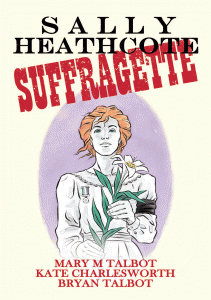I knew only of Mary Talbot as the author of the Costa-winning Dotter of Her Father’s Eyes when, a year ago, she got in touch, sending me PDFs of the bulk of Sally Heathcote Suffragette and asking what I thought of it.
I had no hesitation in deciding that Sally Heathcote Suffragette was a winner.
1) Not only does the book tell the story of the militant suffrage movement with clarity and verve, but, most interestingly, approaches the narrative from an unfamiliar angle. And I must say it is an angle that appeals to me. For Sally’s story applauds the efforts of Frederick and Emmeline Pethick Lawrence, whose work for the cause has been overshadowed by the antics of the more headline-grabbing suffragettes. By not offering any resistance to their ousting from the WSPU by Emmeline and Christabel Pankhurst they have, until now, been consigned to the shadows.
The Pethick Lawrences were militant up to a point – they both went to prison – but they drew the line at bombings and fire-raising. Apart from the danger involved, they could see that this level of violence would only further antagonise both government and public.
Sally Heathcote brings to the fore the social philanthropy – and socialism – that lay at the heart of the Pethick-Lawrences’ involvement in the suffrage cause and their support for pacifism during the First World War. They effected ‘deeds’ – running the Maison Esperance, the Esperance Club and the Green Lady Hostel- as well as publishing ‘words’ – in the shape of the paper Votes for Women. You can read more about the Pethick-Lawrences’ work after their expulsion from the WSPU here.
2) I love the accuracy of Sally Heathcote – not only of the history, but of the visuals. For instance I was very taken by Kate Charlesworth’s drawing of the interior of Lincoln’s Inn House – as in the picture in the bottom frames here.
Below is the interior of Lincoln’s Inn House in reality – a (rather blurry) photo I took in what is now a Bill’s Restaurant last summer. I just love the fact that the detailing of the staircase railing is so right.
I asked if either Kate or Mary had visited the building – but no. We worked out that Bryan’s source had been this page in Votes for Women.
3) All the well-known suffrage scenes are captured brilliantly. You can see from Kate’s drawing of Christabel speaking in Trafalgar Square how her fresh-faced spontaneity had the power to entrance her audience. And I do like the comment in the bottom right of the picture -there’s no doubt Emmeline Pethick-Lawrence’s prose was on occasion over-purpled.
4) I love Sally because one page alone refers to two constituents of the suffrage campaign that have long appealed to me. The first is dear Elizabeth Wolstenholme Elmy, whose life-long efforts have until recently been sadly undervalued. I remember that when the massively long text for my The Women’s Suffrage Movement: a reference guide was being copy-edited, the excellent editor did demur about the length of the entry on Mrs Elmy. However, I managed to convince him that she was really important and that back then, in 1999, very little had been written about her – so she was allowed her long entry. So I’m very pleased that Mary has taken notice of her. The postcard (and, of course, I’m very keen on real photographic postcards) shows her on Mrs Pankhurst’s platform during the 1908 Hyde Park rally. You can just see that Kate has drawn a hint of the bouquet that Mrs Elmy was carrying. Mrs E. mentioned in a letter that it was composed of ferns, purple lilies and lilies of the valley – the colours with which Emmeline Pethick-Lawrence branded the WSPU for this grand occasion.
The second reference is to Maison Esperance – the dressmaking establishment set up by Emmeline Pethick-Lawrence to put her ideals into practice and provide her workers with good working conditions – such as an 8-hour day. I have always thought this a laudable and intriguing enterprise. Alas, as Mary admits in another frame in the text, the experiment did not last long. Was the provision of good working conditions uneconomic? Or was it that the Maison’s garments did not flatter? Why did Emmeline, with her marketing skill, not get the Cara Delevingne or Alexa Chung of the day to be seen wearing them? However, the associated girls’ club and the Green Lady Hostel at Littlehampton were successful.
5) Finally, apart from everything else, I applaud the understated – but very pointed – message in the final frame. Read the book – look at the pictures – and discover what this is.
Do have a look at Mary Talbot’s website to find out more about Sally Heathcote Suffragette – about Mary and Bryan Talbot and Kate Charlesworth – and about associated conferences and book signings.




